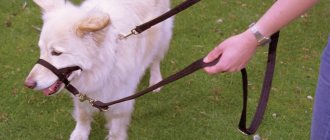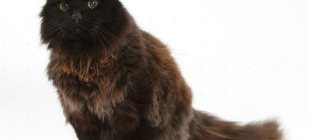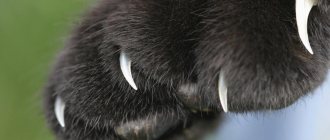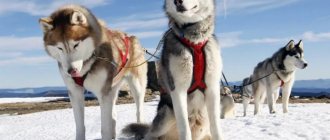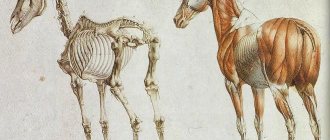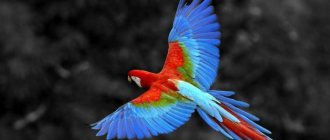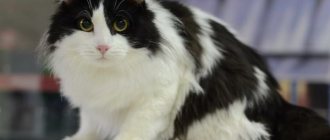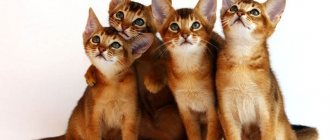The brown horse has a light brown or red color that is lighter on the animal's lower belly, chest and muzzle and slightly darker on the legs and mane. The bangs and the “belt” - the strip along the ridge - are reddish-red in color, and the general shade characteristic of the brown color is sand or reddish-brown. Common color features include a light shade of the body and lighter areas in the groin, belly and muzzle areas.
The brown horse has a light brown or red color
The main characteristic of suits is the saturation and brightness of the main color. If the horse breed is characterized by a yellowish tint, then it is a brown color, and if the color is lighter with some inclusions, then the horse is brown. It is easier to determine, for example, mouse color. The distant ancestors of modern horses rarely had a natural color like this - brown was obtained quite recently as a result of crossing wild and domestic horses, as well as by mutation of some of their genes. Today, “purebred” foals of this color can only be obtained by crossing certain breeds of domestic horses with their wild counterparts, but it should be remembered that this horse is very rare.
The main characteristic of suits is the saturation and brightness of the main color.
Specifics of horses of brown color
The color of a horse or heavyweight is a specific combination of skin color of different parts of the body, including the mane and tail. Color is of great importance for breeding certain breeds of horses, since color combinations and the type of distribution of pigments on the skin often have a genetic predisposition.
The presence or absence of certain useful characteristics and properties of horses is associated with the color.
Suit is a rather broad and “flexible” concept. In each, different patterns can stand out. Professional horse breeders do not have a clear opinion regarding many of these classification subgroups of colors. Some experts recognize certain excuses, others do not.
There are five main and about two dozen derivative colors of horses. Several “wild” ones also stand out. These include colors, combinations and features from which the main modern colors listed above originated.
Brown suit is also considered “wild”. This is the ancestor of the modern redhead. The word itself is of Turkic origin and was borrowed by the Russians from the nomadic steppe people. Another name is red-savrasaya.
Quite a rare color. Occurred as a result of crossing domesticated (savras) horses with their wild “brothers”. Brown color was found in some representatives of the steppe tarpan populations - the extinct ancestors of the modern horse.
Color saturation can vary from very light to dark.
Red-brown shades were found among stallions and mares in herds of wild Przhevalsky horses. This natural color blended well with the steppe terrain, allowing them to camouflage and be invisible to predators.
In what breeds can this variety be found?
An interesting feature of the suit is its exceptional rarity in America. This is due to its origin from wild, indigenous breeds. In America, horses appeared only with the first Europeans, since they were not originally found in nature on this continent.
To breed representatives of this color, local breeds must be specially crossed with imported “wild” horses. But in Asia and Europe there were plenty of native breeds, so the Kauraya is often found here. Most often, the color is present in the following native steppe breeds:
- Yakutskaya.
- Altai.
- Bashkir.
- Kazakh.
A rare representative - a Soviet heavy truck. In Europe, Icelandic ponies and Norwegian fjord horses are brown. In America there are mustangs and some breeds of mixed origin that have Spanish horses among their ancestors:
- Appaloosa.
- Quarter Horse.
- Criollo.
This color is very rare among racing breeds.
Types and colors of brown horses
“Cowness” can be called a special shade that horses received from their distant ancestors with the DUN gene. This gene determines pigmentation. It was inherent in the most ancient ancestors of modern horses.
DUN pigmentation affects the original red color, brightening it. Another feature of the gene is that it does not lighten the entire integument. Based on the above, “brown” refers to a light shade of reddish-brown color.
The brown horse color has the following color features:
- body, legs - reddish, faded;
- head and neck - several shades darker than the body;
- clearing is possible in the area of the eyes, throat, abdomen, groin and croup;
- the mane and tail are reddish-brown, darker than the body, and consist of mixed strands of various shades;
- the metacarpus is dark or black in color;
- in the area of the carpal and hock joints - the highest intensity of reddish;
- “red-red belt” (a pronounced black-brown stripe running along the ridge) - required, red-brown or dark red in color;
- “zebroid” (weakly expressed transverse stripes on the legs) - sometimes has a brown tint.
On a note! An adult or old brown horse has a duller color and may show gray hair. The brightness of the shades is affected by the seasons - darkening in summer, lightening in winter.
According to the research of scientists, we owe the term “kauriy” to the language of the Turks.
A horse can have three shades, which are determined by the saturation of the main shade:
- light brown;
- kauraya;
- dark brown.
Among the character traits that are attributed to brown horses are:
- agreeableness;
- good nature;
- the ability to stand up for oneself;
- strength and endurance.
Where did the name come from?
It is widely believed that the name of the suit comes from the word “brown”, which, in turn, comes from the Turkic kara (“black”). In Russian, dark brown shades are usually called karimi. But since there are also light versions of the brown color, the presented theory is often criticized.
In Russian, the word “kauritsya” means to be gloomy, stubborn and hateful. Therefore, it is likely that the suit got its name not because of the color, but because of the disposition of the wild horses. However, for the horses themselves, such a color is a vital necessity, helping to hide from enemies both in the steppes and in the undergrowth. This became especially relevant for young animals that were not yet able to withstand the attacks of predators.
Distribution of brown horses
Each breed has its own specific set of colors, which is determined by heredity. The red-brown color is quite rare.
Brown color is typical for the following breeds:
- northern European stunted;
- Central Asian and Siberian;
- Soviet heavy trucks.
The color in question is found among Icelandic horses living on a remote northern island. These horses are distinguished by their short stature and adaptability to the harsh conditions of the north. They were brought to Iceland by the Vikings. Due to the ban on importing horses with other characteristics into the country, the purity of the breed was preserved. Friendly and calm horses of the Icelandic breed are very popular in Europe and North America. They are distinguished by their ability to move in five gaits.
In the New World, brown color is present in several breeds - Mustang, Criollo, Appaloosa. Among the European breeds where “kaurost” is represented, one can note the northern one - the Norwegian Fjord. This breed is considered the oldest among all heavy trucks.
Most often, representatives of the brown color are related to the steppe.
Depending on the predominance of a particular color, its name is used as a prefix to the suit.
As can be seen from the list of breeds, “brownness” is characteristic of short populations that have not been subjected to artificial crossing and breeding. Mongolian, Kazakh, Altai and Yakut steppe breeds are close to their “brothers” in their natural habitat - tarpans and Przewalski's horses. This manifestation confirms the “wild” origin of the brown color.
Horses with the considered red-brown tints are almost impossible to meet in equestrian sports and at exhibitions. Such horses are rarely selected for riding. In modern conditions, the suit is found among “hard workers” in rural areas.
Origin story
The spotted horse began to arouse interest in ancient times - this is evidenced by ancient Egyptian historical documents. In addition, archaeological excavations have shown that this color was often found in the steppe herds of Mongolia and China.
But a spotted horse is an atypical phenomenon, this is not a color typical for horses, and therefore the question arises: where did it come from? Experts, through numerous studies, have established that these representatives have a gene anomaly that is transmitted hereditarily. It is this that leads to abnormal pigmentation of the horse’s skin.
In addition, it has been scientifically proven that different genes are responsible for the color of a certain area of the horse's body. Piebaldity is partial albinism. For this reason, horses of this color may have blue irises in one or both eyes. There is also a theory of inbreeding with Mongolian horses, among which those same piebalds were often found. For this reason, piebald horses became common.
Pinto
Attention! As a rule, horses with incredible colors are outbreds of unknown origin. For this reason, they can only occasionally be found among breeders.
In Europe, spotted horses began to be treated with disdain centuries ago. Even in the Middle Ages they were classified as “gypsies”. Their unusual color was considered “cow-like.” The heaviest horse labor fell on their “shoulders.” And this despite the fact that they could not boast of excellent health, because many of their diseases are inherent at the genetic level. The prospect of breeding piebald horses did not attract anyone.
As for the American continents, they were treated completely differently there. Horses were brought to North America by the conquistadors. Most of the horses have gone wild
The extraordinary beauty quickly attracted the attention of local residents. The piebald horse was a symbol of the Wild West; the Indians were sure that such horses would bring them happiness
Piebald horses had a different name; they were called pintos. Somewhat later, an American breed was formed, which is called the American Paint Horse.
American Paint Horse
In the mid-20th century, a community dedicated to piebald horses was created. The founders of the club were horse owners and connoisseurs. Today, horses are used in equestrian tourism, on ranches, and they perform at demonstration events.
Recommendations for caring for brown horses
The beauty of a horse's brown color depends not only on the purity and expression of its basic properties; care and nutrition also play a big role here. Stallions and mares of breeds with a red-brown color are for the most part quite unpretentious. They are perfectly adapted to harsh natural conditions, hardy and strong. But, despite such characteristics, even they require attention and careful care.
Horses are animals that have a high level of communication. They feel best in groups - herds. When alone, the horse experiences discomfort, which is expressed in depression, apathy and aggression. He refuses food and communication. If the owner has one horse, goats or sheep can act as company.
Horse keeping room
For indoor housing, spacious group stalls are best, where horses of the same age can move freely. Stalls and stalls are used as less comfortable premises. It is important here that they have open openings (windows) to communicate with other animals nearby. The minimum area of space per individual is 5 square meters. m.
Keeping horses must include regular cleaning.
The premises must be cleaned and cleaned regularly. Ceilings must be high for effective air ventilation. Drafts should not be allowed. The premises should have good access to natural light.
Stalls are better suited for winter housing, because in the event of an infectious disease, they will reduce the likelihood of the disease spreading.
Keeping fit
To keep the brown horse in shape, it must be walked regularly. In summer, constant grazing of herds is possible. The good weather resistance of brown breeds requires frequent exposure to fresh air. Pasturing allows horses to maintain good physical condition.
There are several varieties of brown color, which depend on the tones of the coat color.
Red-brown horses are often used for work. But you need to adhere to several rules.
- Do not use for work in cold weather with temperatures below -10 °C.
- Before starting work, allow your muscles to stretch.
- Allow to get used to the temperature.
Maintaining hygiene rules for health
Hygiene:
- daily cleaning of the stables - straw, manure, and food debris are removed;
- if there are no horses, the stable can be ventilated by creating a short draft;
- the straw bedding is changed completely once a week, for individual areas as needed;
- showering and washing the horse with laundry soap and special shampoos - once a week;
- In winter and cold weather, carry out water procedures with caution;
- regular cleaning and combing of fur, mane, tail;
- daily inspection of hooves, cleaning and removal of stones, checking horseshoes.
Regular examination by a veterinarian is mandatory. Vaccination against dangerous diseases is carried out in a timely manner.
Diet of horses with brown color
Diet requirements:
- A variety of dry and green food.
- To estimate the daily norm, a feed unit (hereinafter referred to as FU) is used - 1 kg of seeded oats or about 1.5 thousand kcal per 100 kg of animal weight.
- An adult horse requires 1.8–2.7 KE per day. For young animals - 2.2–2.8 KE.
Oats are easily replaced with straw.
In winter, you need to provide your horse with hay.
Daily ration of an adult horse weighing about 500 kg:
- oats - 4-6 kg;
- hay - 10-14 kg;
- bran - 1 kg;
- carrots - 2-4 kg;
- necessarily a small amount of vegetables and fruits.
Oats are served three times a day, hay - five. The daily water intake is about 70 liters of liquid. The amount of water increases or decreases depending on the season, the nature of the feed and the load.

